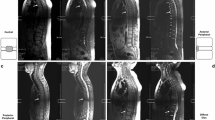Abstract
Background
Predicting functional outcome following surgery performed for spinal cord compression is still a considerable problem. Recent observations, though, strongly suggest that with serial measurements of serum S100b, this might be possible in patients with subacute spinal cord compression. The aim of this study was to examine whether this potential significance of S100b applies as well to patients with spondylotic cervical myelopathy. A further purpose was to assess the value of NSE in this regard, another biochemical marker widely used to monitor cerebral lesions.
Methods
Fifty-one patients were included in this prospective study. Outcome was considered as favourable in case of neurological improvement with preservation or retrieval of walking ability, whereas non-improvement without restoration of gait function was regarded as unfavourable. The preoperative levels of S100b and NSE were correlated with the degree of paresis, duration of symptoms, and presence of intramedullary high signal intensities on MRI. The postoperative values of both markers were correlated with outcome.
Findings
The preoperative levels of S100b were neither correlated with degree or duration of paresis nor with outcome. In case of an uncomplicated course the postoperative levels of S100b were also not correlated with outcome. In complicated courses with acute postoperative deterioration normal values on the 3rd day after the event were associated with a favourable outcome, whereas one patient with unfavourable outcome showed a persistent pathological increase. The serum levels of NSE were not correlated with clinical parameters or with outcome in any of the cases.
Conclusions
Serial S100b serum measurements do not permit prediction of functional outcome in patients with spondylotic cervical myelopathy in case of an uncomplicated postoperative course. In complicated courses with postoperative deterioration, such measurements reflect postoperative events with possibly prognostic relevance. NSE does not have any significance in these patients with chronic lesions of the spinal cord.



Similar content being viewed by others
References
Arnasson O, Carlsson CA, Pellettieri L (1987) Surgical and conservative treatment of cervical spondylotic radiculopathy and myelopathy. Acta Neurochir (Wien) 84:48–53
Bertalanffy H, Eggert HR (1988) Clinical long-term results of anterior discectomy without fusion for treatment of cervical radiculopathy and myelopathy. A follow-up of 164 cases. Acta Neurochir (Wien) 90:127–135
Chung SS, Lee CS, Chung KH (2002) Factors affecting the surgical results of expansive laminoplasty for cervical spondylotic myelopathy. Int Orthop 26:334–338
Ebersold MJ, Pare MC, Quast LM (1995) Surgical treatment for cervical spondylitic myelopathy. J Neurosurg 82:745–751
Emery SE, Bohlman HH, Bolesta MJ, Jones PK (1998) Anterior cervical decompression and arthrodesis for the treatment of cervical spondylotic myelopathy. Two to seventeen-year follow-up. J Bone Joint Surg Am 80:941–951
Kohno K, Kumon Y, Oka Y, Matsui S, Ohue S, Sakaki S (1997) Evaluation of prognostic factors following expansive laminoplasty for cervical spinal stenotic myelopathy. Surg Neurol 48:237–245
Kumar VG, Rea GL, Mervis LJ, McGregor JM (1999) Cervical spondylotic myelopathy: functional and radiographic long-term outcome after laminectomy and posterior fusion. Neurosurgery 44:771–777
Marquardt G, Setzer M, Seifert V (2004) Protein S-100b as serum marker for prediction of functional outcome in metastatic spinal cord compression. Acta Neurochir (Wien) 146:449–452
Marquardt G, Setzer M, Seifert V (2004) Protein S-100b for individual prediction of functional outcome in spinal epidural empyema. Spine 29:59–62
Mehalic TF, Pezzuti RT, Applebaum BI (1990) Magnetic resonance imaging and cervical spondylotic myelopathy. Neurosurgery 26:217–226
Morio Y, Yamamoto K, Kuranobu K, Murata M, Tuda K (1994) Does increased signal intensity of the spinal cord on MR images due to cervical myelopathy predict prognosis? Arch Orthop Trauma Surg 113:254–259
Naderi S, Ozgen S, Pamir MN, Ozek MM, Erzen C (1998) Cervical spondylotic myelopathy: surgical results and factors affecting prognosis. Neurosurgery 43:43–49
Saunders RL, Bernini PM, Shirreffs TG Jr, Reeves AG (1991) Central corpectomy for cervical spondylotic myelopathy: a consecutive series with long-term follow-up evaluation. J Neurosurg 74:163–170
Yamazaki T, Yanaka K, Sato H, Uemura K, Tsukada A, Nose T (2003) Cervical spondylotic myelopathy: surgical results and factors affecting outcome with special reference to age differences. Neurosurgery 52:122–126
Yone K, Sakou T, Yanase M, Ijiri K (1992) Preoperative and postoperative magnetic resonance image evaluations of the spinal cord in cervical myelopathy. Spine 17(10 Suppl):388–392
Author information
Authors and Affiliations
Corresponding author
Additional information
Comment
This is a prospective study of 51 patients with cervical spondylotic myelopathy. Poor outcome (acute postoperative deterioration) was found to be associated with increased S100b serum levels, which may be of prognostic significance. However, this is of limited clinical value and would not necessarily change decisions in patient management. In an age where doctors and particularly patients want more information about prognosis, serum markers are an obvious candidate for providing such information, and this forms the basis for the study.
David Choi
National Hospital for Neurology and Neurosurgery,
London, UK
Rights and permissions
About this article
Cite this article
Marquardt, G., Setzer, M., Szelenyi, A. et al. Significance of serial S100b and NSE serum measurements in surgically treated patients with spondylotic cervical myelopathy. Acta Neurochir 151, 1439–1443 (2009). https://doi.org/10.1007/s00701-009-0408-0
Received:
Accepted:
Published:
Issue Date:
DOI: https://doi.org/10.1007/s00701-009-0408-0




